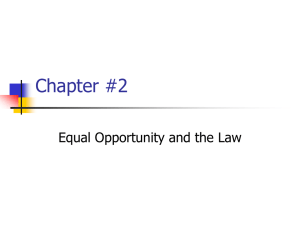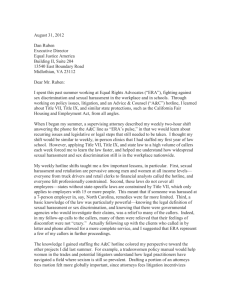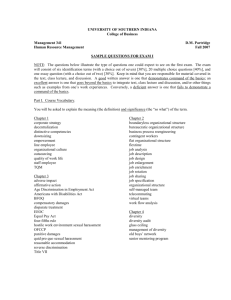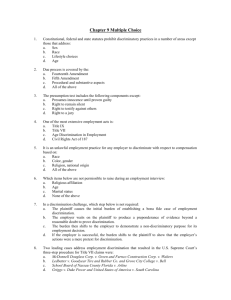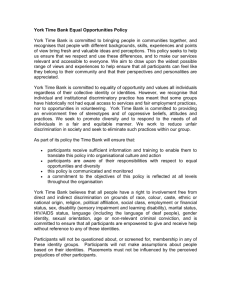ADA (cont.)
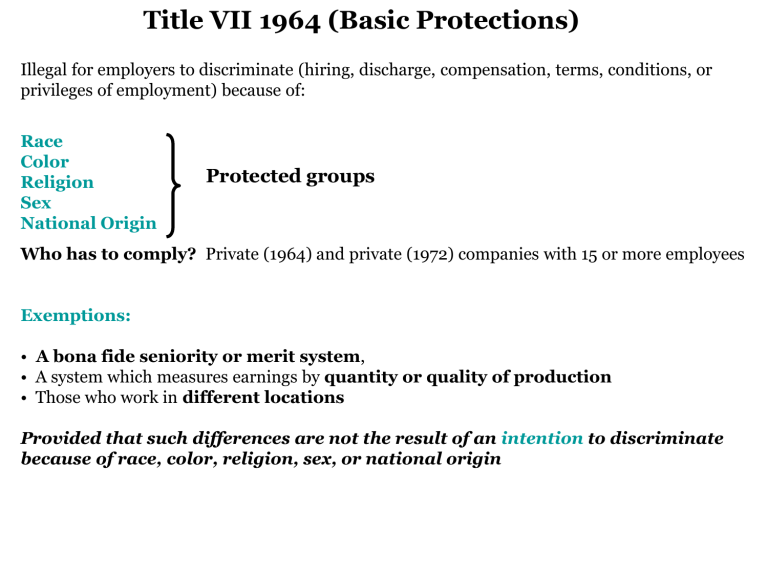
Title VII 1964 (Basic Protections)
Illegal for employers to discriminate (hiring, discharge, compensation, terms, conditions, or privileges of employment) because of:
Race
Color
Religion
Sex
National Origin
Protected groups
Who has to comply? Private (1964) and private (1972) companies with 15 or more employees
Exemptions:
• A bona fide seniority or merit system,
• A system which measures earnings by quantity or quality of production
• Those who work in different locations
Provided that such differences are not the result of an intention to discriminate because of race, color, religion, sex, or national origin
Title VII 1964 (Basic Protections, cont.)
Not illegal to give and to act upon the results of any professionally
developed ability test provided that such test, its administration or
action upon the results is not designed, intended or used to discriminate because of race, color, religion, sex or national origin.
Test Scores --Cannot, on the basis of race, color, religion, sex, or national origin,
• Adjust scores
• Use different scores
• Alter results of tests
Griggs v. Duke Power
Basic Principles :
A) All requirements and "tests" must be related to the job
B) Intent to discriminate does not need to be proven
C) If disparate impact is shown to exist, then the burden of proof is on the company to justify its requirements (show that they are job related and related to business necessity
D) Disparate impact (as well as disparate treatment) is prohibited by Title VII
• Use of the 4/5 rule
Adverse Impact
Adverse impact and the ``four-fifths rule.'' A selection rate for any race, sex, or ethnic group which is less than four-fifths (4/5) (or eighty percent) of the rate for the group with the highest rate will generally be regarded by the Federal enforcement agencies as evidence of adverse impact, while a greater than four-fifths rate will generally not be regarded by Federal enforcement agencies as evidence of adverse impact.
Smaller differences in selection rate may nevertheless constitute adverse impact, where they are significant in both statistical and practical terms or where a user's actions have discouraged applicants disproportionately on grounds of race, sex, or ethnic group.
Greater differences in selection rate may not constitute adverse impact where the differences are based on small numbers and are not statistically significant, or where special recruiting or other programs cause the pool of minority or female candidates to be atypical of the normal pool of applicants from that group.
From the Uniform Guidelines on Employee Selection Procedures
Basic Adverse Impact Example
Group Applicants Hired Selection ratio (SR)
Non-minority 100 20 .20
Minority 50 ? ?
• Is the selection ratio of minorities less than 4/5 (.80) of the non-minority group?
• If number of minorities hired is 5, is adverse impact present?
• If number of minorities hired is 9, is adverse impact present?
Connecticut v. Teal
Disparate impact analysis and the "bottom line"
Multiple hurdle process was used to make personnel decisions
A significantly greater % of minorities (black males) failed the 1st test
No difference in the % of blacks and whites eventually promoted
S.C. All “tests” must be demonstrated to be job-related despite the overall,
“bottom-line numbers
Disparate Impact Process
Phase 1 : Challenger --- Evidence (often statistical) that a specific, identified employment practice disproportionately excludes protected group members
(establishment of a prima facie case)
• Often a comparison of two percentages; % within a company and % outside the company
(representation statistics)
• Relevant labor market (those possessing requirements for the job in a given area (e.g., city, state, region, national)
Phase 2 : Company --- Proof that the challenged practice is job-related and consistent with business necessity
Phase 3 : Challenger --- Proof there is an equally valid, job-related practice with less or no adverse impact
Representation
“Statistics showing racial or ethnic imbalance are probative in a case such as this one only because such imbalance is often a telltale sign of purposeful discrimination; absent explanation, it is ordinarily to be expected that nondiscriminatory hiring practices will in time result in a work force more or less representative of the racial and ethnic composition of the population in the community from which employees are hired. Evidence of long lasting and gross disparity between the composition of a work force and that of the general population thus may be significant even though 703 (j) makes clear that
Title VII imposes no requirement that a work force mirror the general population." From Teamsters v. U.S.
(j) Nothing contained in this subchapter shall be interpreted to require any employer, … to grant preferential treatment to any individual … on account of an imbalance which may exist with respect to the total number or percentage of persons of any race, color, religion, sex, or national origin employed by any employer,… in comparison with the total number or percentage of persons of such race, color, religion, sex, or national origin in any community , or in the available work force in any community … State,section, or other area.
From Section 703 Title VII
Differential Treatment Discrimination
1) Plaintiff [Standards for a Establishing a Prima Facie Case]
• Applicant belongs to a protected group
• Applicant applied and was qualified for a job the employer was trying to fill
• Applicant, though qualified, was rejected for the position
• Employer continued to seek applicants with applicant’s qualifications
2) Defendant :
A legitimate nondiscriminatory reason exists for the rejection of the person
3) Plaintiff:
The organization's reason for the rejection is a pretext for discrimination
Basic Approaches to Affirmative Action
• Passive (color blind system)
• Pure (Expand recruitment, encourage minority applicants)
• Affirmative Action With Preferential Treatment (e.g., use of minority status as a
“plus” factor)
• Hard Quotas (set number, or percent, of minority positions given to minorities)
Affirmative Action Factors Supported By the Supreme Court
Remedial in Nature (e.g., past evidence or findings of discrimination)
Narrowly tailored plan
Voluntary (e.g., employer adoption of a AA plan where a statistically significant disparity exists between percent of minorities within the company versus the percent existing in the relevant labor market)
Limited Duration (a temporary time frame exists)
Rights of Those Not Benefited by the System are Protected
• Protection of jobs
• Use of minority status as “plus” factors
Equal Pay Act (1963)
Must pay males and females, with the same establishment, equal rates for jobs requiring equal:
• Skill
• Responsibility
• Effort
• Work conditions
Exemptions (affirmative defenses):
• A seniority system
• A merit system
• A system which measures earnings by quantity or quality of production
• Any factor other than sex
EPA (cont.)
SEC. 206. [Section 6] (d) (1) No employer having employees subject to any provisions of this section shall discriminate, within any establishment in which such employees are employed, between employees on the basis of sex by paying wages to employees in such establishment at a rate less than the rate at which he pays wages to employees of the opposite sex in such establishment for equal work on jobs the performance of which requires equal skill, effort, and responsibility, and which are performed under similar working conditions , except where such payment is made pursuant to (i) a seniority system ; (ii) a merit system ; (iii) a system which measures earnings by quantity or quality of production ; or (iv) a differential based on any other factor other than sex: Provided , That an employer who is paying a wage rate differential in violation of this subsection shall not , in order to comply with the provisions of this subsection, reduce the wage rate of any employee .
Ledbetter should have filed an EEOC charge within 180 days after each allegedly discriminatory employment decision was made and communicated to her. Her attempt to shift forward the intent associated with prior discriminatory acts to the 1998 pay decision is unsound, for it would shift intent away from the act that consummated the discriminatory employment practice to a later act not performed with bias or discriminatory motive, imposing liability in the absence of the requisite intent.
Lilly Ledbetter Fair Pay Act of 2009 (H.R. 11)
SEC. 3. DISCRIMINATION IN COMPENSATION BECAUSE OF RACE,
COLOR, RELIGION, SEX, OR NATIONAL ORIGIN.Section 706(e) of the
Civil Rights Act of 1964
‘(3)(A) For purposes of this section, an unlawful employment practice occurs, with respect to discrimination in compensation in violation of this title, when a discriminatory compensation decision or other practice is adopted, when an individual becomes subject to a discriminatory compensation decision or other practice, or when an individual is affected by application of a discriminatory compensation decision or other practice, including each time wages, benefits, or other compensation is paid, resulting in whole or in part from such a decision or other practice.
Age Discrimination in Employment Act (ADEA)
Basic Protections
• Protected group – Individuals 40 years of age or older (employees and job applicants)
Two Basic defenses in ADEA cases ---
(1) BFOQ
A) “That the BFOQ is reasonably necessary to the essence of the business” and
B) “That it has reasonable cause, i.e., a factual basis for believing that all or substantially all persons within the protected age group would be unable to perform safely and efficiently the duties of the job involved, or whether it is impossible or impractical to deal with persons in the protected age group on an individual basis” (Usery v. Tamiami Trail Tours, Inc. 1976, pg. 1241-
1242).
(2) Reasonable Factor Other Than Age (RFOA)
• Company must offer proof that the factor used was NOT age but another factor that is not unreasonable (even though the “other” factor is related to age such as job tenure)
ADEA Burden of Proof Process
Phase 1: Challengers must establish a prima facie case by providing evidence of age discrimination by showing that:
• They are 40 years old or older
• They were qualified for the position in question
• They were victims of an unfavorable employment decision (e.g., not hired, promoted, fired)
• The organization favored an individual who was considerably younger than the challenger
Phase 2: Company must articulate that a legitimate, nondiscriminatory reason exists for their decision
Phase 3: The challenger proves that the organization's reason for their rejection is a pretext for discrimination
Role of Individual Assessment
Western Airlines v. Criswell (1985)
Western Airlines policy forced flight engineers to retire at age 60;
Criswell filed an ADEA suit and met his Phase 1 burden under the ADEA
Phase 2: Western Airlines claimed that age was a BFOQ
• Their primary business was the safe transportation of passengers
• They had a rational basis for believing those over 60 were not qualified
• Testing the ability of all flight engineers age 60 or above was impractical
Supreme Court Decision in Criswell
ADEA intended a BFOQ to be a relatively narrow exception; a lot of individual variation exists
The S. Ct. said that the ADEA indicates a:
“ ... preference for individual evaluation expressed in the language and legislative history of the ADEA. Under the Act, employers are to evaluate employees … on their merits and not their age. In the BFOQ defense,
Congress provided a limited exception to this general principle, but required that employers validate any discrimination as "reasonably necessary to the normal operation of the particular business." It might well be "rational" to require mandatory retirement at any age less than 70, but that result would not comply with Congress' direction that employers must justify the rationale for the age chosen.”
Other problems with Western Airline’s positions were the fact that:
• Other airlines did not require mandatory retirement before age 70
• Western Airlines used individualized tests in other, comparable situations
• The Federal Aviation Administration believed that individualized testing was practical for such jobs.
Criswell won.
O'Conner v. Consolidated Coin Caterers (1996)
Brief Facts:
• O’Conner, 67 years old, was replaced him with someone age 40 (i.e., someone in the protected age group)
• The organization said the O’Conner did not establish a prima facie case because he was replaced by an individual who was also in the protected age group
Supreme Court: The ADEA was meant to disallow discrimination because of age . Therefore, the critical evidence for age discrimination in this case was that the person who replaced the fired employee was substantially younger .
“The fact that one person in the protected class has lost out to another person in the protected class is thus irrelevant, so long as he has lost out because of his age. … there can be no greater inference of age discrimination … when a 40 year old is replaced by a 39 year old than when a 56 year old is replaced by a 40 year old. …the fact that a replacement is substantially younger than the plaintiff is a far more reliable indicator of age discrimination than is the fact that the plaintiff was replaced by someone outside the protected class.”
Supreme Court Ruling in Smith
• In a 5-3 ruling, S.Ct. rules that adverse impact is available in
ADEA
• Adverse impact follows same prima facie (Phase 1) rules in Title VII and ADEA --- Statistical evidence of an identified employment practice that disproportionately excludes protected group members
• Unlike Title VII, which demands proof of job-relatedness & consistency with business necessity (in Phase 2) forcing the plaintiff to prove an equally valid practice with less or no adverse impact (in Phase
3)
• But, the ADEA permits the RFOA defense in Phase 2 forcing plaintiffs to prove that factors advanced are not reasonable (Phase 3)
THUS ------->
GRIGGS-ALBE MARL E (TITLE VII)
Prima Facie
Defense
Pretext
Statistical evidence of an identified emp loyment p ractice that disprop ortionately excl udes protected group members
Proof that the challenged p ractice is job-related and consistent with business necessity
Proof there is an equally valid, job -related practice with less or no adverse impact
SMITH V. CITY OF JACKS ON (ADEA)
Prima Facie
Defense
Pretext
Statistical evidence of an identified emp loyment p ractice that disprop ortionately excl udes protected group members
Proof that the challenged p ractice is sup p orted by a Reasonable
Factor Other Than Age (RFOA)
Proof that the factor cited is unreasonable, or not the true reason for the emp loyment p ractice
Americans With Disabilities Act (ADA)
Disability : A qualified individual (able to perform the essential functions of the job with or without reasonable accommodation ) who:
1) Has a physical or mental impairment that substantially limits a major life activity (e.g., hearing, seeing, speaking, breathing, performing manual tasks, walking, caring for oneself, learning or working)
2) Has a record of a substantially limiting impairment
3) Is regarded as having a substantially limiting impairment
ADA (cont.)
>> Qualified = Possessing the required KSAs for the job (with or without reasonable accommodation)
If not, an insurmountable barrier exists to pursue an ADA claim
Essential functions (not marginal ones):
• Evidence (job descriptions, job analysis)
>> Direct Threat to Safety
• Type of job/work
• Significant risk?
Infectious diseases (nature of risk, duration, severity, likelihood of transmission)
Ability to safely perform essential job duties (e.g., diabetic and driving, epilepsy and operating heavy machinery, asthmatics and firefighters
• Role of reasonable accommodation (eliminate threat?)
Reasonable Accommodation:
Factors used in its determining:
• the cost of the accommodation
• the employer's size
• financial resources
• the nature and structure of a company’s operations
ADA
(cont.)
Examples of reasonable accommodations :
• acquiring or modifying equipment or devices
• job restructuring
• part-time or modified work schedules
• reassignment to a vacant position (and those occurring in near future)
• medical leave (must be time-barred)
• adjusting or modifying examinations, training materials or policies
• providing readers and interpreters
• making the workplace readily accessible to and usable by people with disabilities .
Drug testing is allowed under the ADA
But, a company cannot exclude someone who has successfully completed a rehabilitation program and is not currently using illegal drugs
Timeframe issue [e.g., some considerable length]
ADA (cont.)
Organizations are Not required to:
• Reallocate essential job duties
• Creating a new position
• Preference to disabled applicants/employees
• Lower production/quality performance standards
• Allow work at home (attendance often ruled as essential)
Overall category of manual tasks not sufficient (if it is restricted to a given job)
Examples of disabilities considered to affect major life activities: brain damage, kidney disorder, severe irritable bowel syndrome, eating, sleeping, cognitive ability)
ADA (cont.)
Substantially Limits:
• Significantly more severe than those experienced by the average person
• Not temporary in nature (e.g., back injury, broken leg, heart attack)
Major Life Activity:
Must affect a broad range of activities or jobs (e.g., not limited to a specific job)
[Examples: pilot, police officer, firefighter, etc.]
Role of mitigating (correctable) factors
• The determination of being disabled must take into consideration the impact of factors that can offset a disability (e.g., eye glasses, high blood pressure medication)
• ADAAA (2009)
Basic Components of the Americans With Disabilities
Amendments Act (ADAAA)
• Disabilities must be considered in their uncorrected state (an exception is the use of regular eyeglasses or contact lenses)
• Working is included as a major life activity, and it is separate from the major activities of performing manual tasks and caring for oneself
• To be considered as substantially limited, the recovery period for an individual with an transitory impairment (e.g., heart attack) must be 6 months or longer
• Disorders that are episodic or in remission (e.g., tuberculosis) must be considered when they are in their active state
ADA (cont.)
Medical examinations & inquiries about disabilities
>>> An employer may not ask or require a job applicant to take a medical examination before making a job offer
Exceptions:
• Asking if the applicant can perform essential, job-related functions
• Asking applicants to demonstrate how they would perform job duties
• For applicants with an obvious disability (e.g., amputee, wheelchair) --- may inquire about necessary accommodation
MMPI and the ADA
Karraker v. Rent-A-Center, Inc. 411 F, 3rd 831 (7th Cir. 2005)
The MMPI fits the definition of a “medical examination” --- a “procedure or test that seeks information about an individual’s physical or mental impairments or health.”
They held that the MMPI was designed to reveal mental impairment/disorders --- thus was a violation of the ADA.
Maternity and parental leave policies:
A comparative view (before the FMLA)
Country Duration
Canada
Italy
17 – 41 weeks
22 –48 weeks
Germany 14 – 26 weeks
Sweden 12 – 52 weeks
Finland 35 weeks
Austria
Chile
18 – 52 weeks
18 weeks
United
States
0
Job security
Yes
Yes
Yes
Yes
Yes
Yes
Yes
0
Amount/duration
60% / 15 weeks
80% / 22 weeks
100% / 14-18 weeks
90% / 36 weeks
100% / 35 weeks
100% / 20 weeks
100% / 18 weeks
0
Recipient
Mother
Mother
Mother
Mother or
Father
Mother or
Father
Mother
Unspecifie d
0
The Pregnancy Discrimination Act
92 STAT.2076 Public Law 95-555 – October 31, 1978
Public Law 95-999 95th Congress.
An Act
Oct. 31, 1978 (S.995) To amend title VII of the Civil Rights Act of 1964 to prohibit sex discrimination on the basis of pregnancy. .Pregnancy sex discrimination, prohibition. 42
USC 2000e. Definitions. Be it enacted by the Senate and House of Representatives of the United
States of America in congress assembled, That section 701 of the Civil Rights Act of 1964 is amended by adding at the end thereof the following new subsection: “(k) The terms ‘because of sex’ or ‘on the basis of sex’ include, but are not limited to, because of or on the basis of pregnancy, childbirth, or related medical conditions ; and women affected by pregnancy, childbirth, or related medical conditions shall be treated the same for all employmentrelated purposes, including receipt of benefits under fringe benefit programs , as other persons not so affected but similar in their ability or inability to work, and nothing in section
703(h) 42 USC2000e—2.of this title shall be interpreted to permit otherwise. This subsection shall not require an employer to pay for health insurance benefits for abortion, except where life of the mother would be endangered if the fetus were carried to term, or except where medical complications preclude an employer from providing abortion benefits or otherwise affect bargaining agreements in regard to abortion.
Family and Medical Leave Act (1993)
• Applies to organizations with 50 or more employees (originally was 15 or more)
• 12 weeks of leave for any 12 month period (leave is unpaid ; originally was 26 weeks for medical and 18 weeks for family leave)
• Covers mothers and/or fathers
Leave reasons:
• Birth and caring for a child
• Adoption or foster care for a child
• Care for a spouse, child, or parent with a serious health condition
• Serious health condition of the employee (unable to perform job functions)
• Job security is protected (must be given same or equivalent position)
• Key employees not covered (those among the highest paid 10 percent of the employees working for the company within 75 miles of the facility at which the employee is employed)
Sexual Harassment (Basic Points)
1) Quid Pro Quo (sex as a condition of employment or basis for employment decisions)
2) Environmental harassment (behavior of a sexual nature that is unwelcome and that unreasonably interferes with one’s work performance or creates an intimidating, hostile , or repressive work environment)
Sexual Harassment (Some Key Factors)
• Investigating the record as a whole
• Viewing the totality of the circumstances (e.g., nature of the relationship, nature of the sexual advances, context in which the behaviors occurred)
• Examining the evidence on a case by case basis
• Conduct is potentially illegal if the organization “ knew or should have known ” of sexual behavior
Sources of harassment:
• Supervisors (company responsibility; agent of the company)
• Co-workers (corrective action)
• Clients (extent of company control)
Meritor Savings v. Vinson Findings (1986)
1) Sexual harassment is a form of sex discrimination and thus a violation of Title
VII of the Civil Rights Act
2) Both “tangible job benefit” (Quid Pro Quo) and “environmental” harassment are violations of Title VII. That is, it can exist under conditions where it creates a hostile or repressive work environment.
3) A company is not immune from legal liability when it had a grievance procedure and policy against sexual harassment.
4) Even if sexual behavior is “ voluntary ” the key is that it is “ unwelcome .”
5) The plaintiff’s “provocative” behavior and dress are admissible as evidence.
6) A company is not automatically liable for “environmental” sexual harassment
Supreme Court (Harris v. Forklift Systems)
"You're a woman, what do you know"
"We need a man as the rental manager“
Told her she was "a dumb ass woman."
Suggested that the two of them "go to the Holiday Inn to negotiate a raise."
Asked Harris and other female employees to get coins from his front pants pocket.
Threw objects on the ground in front of Harris and other women, and asked them to pick the objects up.
Made innuendos about Harris’ and other females employee’s clothing
Harris complained to Hardy and he was surprised she was offended by his behavior. But, he promised to stop. However, a few weeks later as Harris was working on a deal with a client, Hardy commented: “What did you do, promise the guy . . . some [sex] Saturday night?" Harris quit.
Supreme Court (Harris v. Forklift Systems)
No requirement that the behavior results in serious psychological injury
We therefore believe the District Court erred in relying on whether the conduct
"seriously affect[ed] plaintiff's psychological wellbeing" or led her to "suffer” injury." Such an inquiry may needlessly focus the fact finder's attention on concrete psychological harm , an element Title VII does not require. So long as the environment would reasonably be perceived, and is perceived, as hostile or abusive , Meritor, supra, at 67, there is no need for it also to be psychologically injurious.
1.
2.
3.
Vignettes
A group of male sales representatives come to see you. They say they no longer want to be sent on out-of-town assignments with female colleagues because they are afraid of sexual harassment charges.
Do you assure the men they don’t have to travel with women?
Tell the men their fears are groundless?
Arrange for a sexual harassment training session?
Call a department meeting to discuss the matter?
Barb just lost a lot of weight. She starts coming to work in very short, tight skirts and clinging tops.
Do you ask nothing?
Call Barb in to tell her to dress more appropriately?
Send Barb a memo asking her to dress more appropriately?
XYZ Company is your biggest account. The buyer has been making unwelcome sexual advances to several women in your office.
Do you ask the women to ignore it?
Tell the buyer not to come back?
Tell the buyer to change his behavior?
Call the buyer’s boss?
Vignettes (cont.)
4.
5.
Ann, a female supervisor, has recently complained to management about the ongoing sexual advances and innuendo to which she is exposed on the plant floor.
The Plant Manager reminded her that she was informed about this climate before she accepted her position. She has been told that she is going to have to be more assertive and learn to deal with this if she expects to keep her job.
Richard and Janet have worked together for several years. Richard grabbed
Janet’s behind when she was drinking from the water fountain. When Janet objected, Richard apologized and has never repeated this behavior again.
